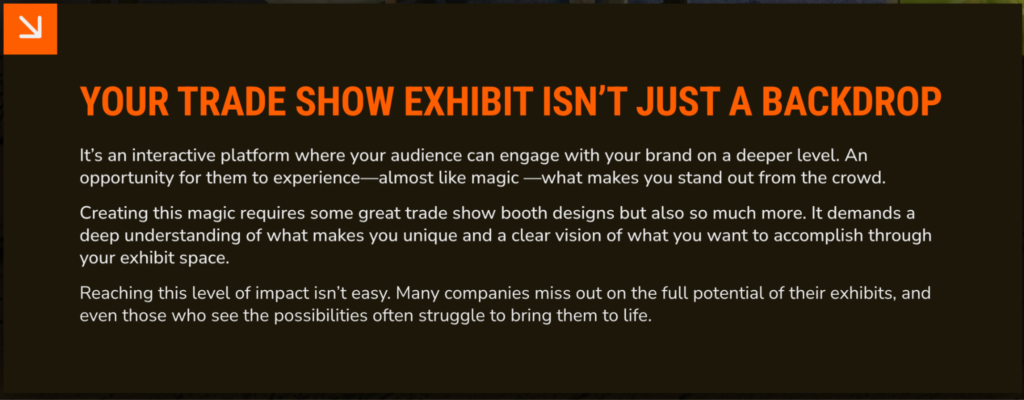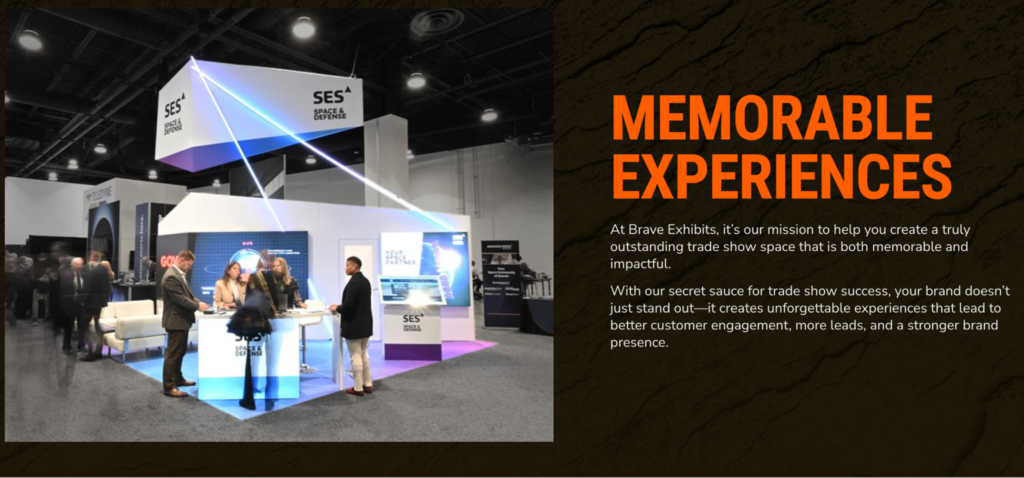Trade show booths come in all shapes and sizes, but if you’re aiming to make an impact, the conversation around booth size should be a lot more nuanced than simply deciding on square footage. As trade show exhibit designers, we know that the size of your trade show backdrop or booth space is just one piece of a larger puzzle. The key is balancing your brand’s visual presence, messaging, and the flow of attendee interaction to create a cohesive experience that keeps people talking—and returning. Here’s a guide, inspired by Brave Exhibits, to help you choose a backdrop that maximizes your trade show booth’s impact.

Aligning Backdrop Size with Booth Type
Small booth spaces can significantly affect trade show backdrop choice. Here’s what works best for each setup:
- 10×10 Booths: Compact backdrops like pop-ups or retractable banners fit well, maximizing visibility without overwhelming.
- 10×20 Booths: Tension fabric or modular displays provide wider visual space for messaging.
- Island Booth: Ideal for 360-degree visuals, these require a booth design and can incorporate multi-panel or wraparound designs, creating immersion.
- Peninsula Booth: usually positioned at the end of an aisle or row, a peninsula is a trade show booth setup that has aisles on three sides and is typically connected to another exhibit on the back side. It’s usually larger than a standard inline booth and can vary in size, with common dimensions being 10×20 feet or larger.
Tip: Visualize your setup to ensure the backdrop enhances the booth and aligns with your overall trade show display.

Brave Exhibits customer, Solifi showcases a sleek, clean trade show exhibit at events like the Equipment Leasing and Finance Association Annual Convention, where attendees could talk to Solifi’s support team and learn about their secured finance technology solutions.
Analyze Competitor Backdrops
Many brands still rely on the same old 10×10 trade show backdrops, assuming they’re industry-standard, and let’s face it—safe. But trade show planning should be a calculated decision based on your goals, audience expectations, and space dynamics. Ok, yes, and your budget. If you’re opting for a 10×10 or even a 10×20 corner booth or exhibit, understand that backdrop choice will shape how visitors experience your brand. Don’t settle for anything that doesn’t align with the exact story you want to tell in that limited space. If you’re looking for booth ideas, then we also got you covered.
For an inline booth—the classic choice in trade show setups—your backdrop can either make or break your presence. If it’s a small space, choose a clean, bold design to capture attention without overwhelming. A tension fabric backdrop, light box design, or modular system with precise brand messaging is more impactful than a cluttered, wrinkled, display that visitors gloss over.
Reviewing competitors’ displays and your neighboring booth offers valuable insights. Consider these factors:
- Differentiation: Study color schemes and graphics to choose elements that set your brand apart, whether through bold colors or sleek minimalism.
- Audience Engagement: Observe which setups draw attention and use interactive elements like touchscreens or QR codes to enhance visitor interaction.
- Message Clarity: Avoid clutter. Use readable font sizes and focus on a single impactful message.
TIP: Review their visual layouts, color schemes, and crowd engagement techniques. If everyone is using dark tones, break the mold with light, bright hues that signify approachability and energy. Remember, in a sea of booths, your backdrop is your brand’s invitation; make sure it’s one that stands out.

Matching Your Brand and Goals
A backdrop should communicate your brand’s identity. Focus on:
- Core Branding: Use colors and fonts consistent with your brand for recognition.
- Clear Message: Incorporate taglines or product highlights that are easy to read from a distance.
- High-Quality Graphics: Invest in professional, high-resolution visuals with intentional lighting.
Popular Backdrop Styles for Every Booth Type
Each backdrop style has unique benefits. Consider these options:
- Pop-Up Displays: Lightweight and portable, perfect for small booth spaces needing seamless visuals.
- Retractable Banners: Cost-effective, easy to transport, suitable as side elements for inline booths.
- Tension Fabric Backdrops: Ideal for high-quality visuals, offering a sleek, wrinkle-free look.
- Modular Systems: Great for companies attending multiple shows, allowing reconfiguration for different layouts.

Durability and Practicality
If you exhibit at multiple shows, a durable backdrop maximizes ROI. Key factors:
- Material: Tension fabrics and vinyl are both durable. Tension fabrics offer a smooth, wrinkle-free appearance, while vinyl is easy to clean.
- Easy Assembly: Pop-up and modular options save time with quick setup.
- Proper Storage: Following manufacturer instructions keeps backdrops looking fresh.
Avoid Common Backdrop Selection Mistakes
Maximize booth effectiveness by steering clear of these pitfalls:
- Oversized Backdrops: Large backdrops can crowd the space. Ensure it fits without restricting visitor movement.
- Underused Space: A too-small backdrop may look incomplete. Utilize booth height and width to create a full display.
- Cluttered Content: Simplify messaging and graphics for a clean, professional look.
When to Upgrade to a Larger Backdrop or Booth Space
Here are instances where a larger booth may be beneficial:
- High Foot Traffic: For high-traffic shows, a larger backdrop offers more space to engage visitors and showcase brand messaging.
- Product Demos: If hosting live demos or interactive displays, more space allows for demo stations or interaction zones.
- Competitive Landscape: Larger booths help match or outshine competitors, making a bolder statement.
- Expanded Offerings: Companies with multiple products benefit from spacious layouts for each offering.
- Brand Presence Goals: A larger footprint allows for immersive experiences, ideal for brands aiming to strengthen their identity.

When to Downgrade or Opt for a Smaller Backdrop
A smaller booth size can also be advantageous under certain conditions:
- Focused Offering: For single-product promotions, a compact, well-designed backdrop focuses attention where needed. Your location on the trade show floor will matter.
- Budget Constraints: A smaller exhibit booth is more cost-effective in setup, transport, and storage.
- Niche Audience: At specialized trade shows, a smaller booth encourages deeper engagement with a targeted audience.
- Testing New Branding: A smaller booth offers a cost-effective space to experiment with messaging.
- Inline Booth Setup: These work well for simpler displays and are arranged in a line between other exhibitors, maximizing straightforward visitor engagement.

Final Considerations
- ROI Analysis: Weigh costs against potential ROI to choose the right size.
- Future Flexibility: Modular booths provide expansion and contraction flexibility based on event requirements.
- Adaptability and Reusability: Modular setups with adjustable backdrops allow resizing without needing multiple investments.
Conclusion

In exhibit design, there are no one-size-fits-all solutions. Your booth space and backdrop aren’t just practical necessities—they’re your brand’s main stage. Investing in design that’s finely tuned to your brand identity, goals, and event strategy isn’t just smart; it’s essential. At Brave Exhibits, we believe a booth should resonate deeply with your audience, not just decorate the show floor. Remember, an exceptional trade show presence isn’t just about showing up—it’s about showing up differently.


